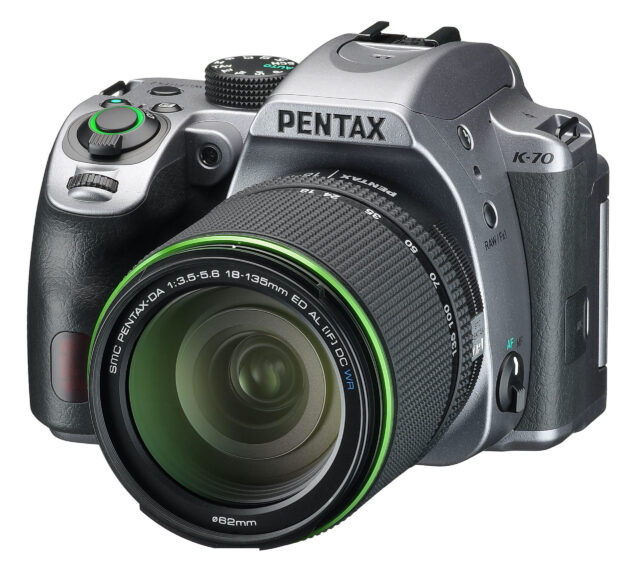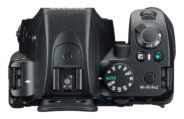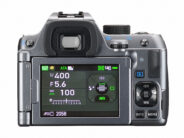Announced
Production status
System
Pentax K APS-C system cameras
- Pentax *ist D
- Pentax *ist DL
- Pentax *ist DL2
- Pentax *ist DS
- Pentax *ist DS2
- Pentax K-3
- Pentax K-3 II
- Pentax K-3 III
- Pentax K-3 III Monochrome
- Pentax K-30
- Pentax K-5
- Pentax K-5 II
- Pentax K-5 IIs
- Pentax K-50
- Pentax K-500
- Pentax K-7
- Pentax K-70
- Pentax K-m
- Pentax K-r
- Pentax K-S1
- Pentax K-S2
- Pentax K-x
- Pentax K100D
- Pentax K100D Super
- Pentax K10D
- Pentax K110D
- Pentax K200D
- Pentax K20D
- Pentax KF
- Pentax KP
Pentax K-70
APS-C AF digital SLR camera • Discontinued
Specification
| Format: | |
| APS-C | |
Imaging sensor: | 23.5 × 15.6mm CMOS sensor |
Resolution: | 6000 × 4000 - 24 MP |
Crop factor: | 1.53x |
Sensor-shift image stabilization: | Yes |
| Pentax K [45.5mm] | |
| Shutter: | |
Type: | Focal-plane |
Model: | Electronically controlled |
Speeds: | 30 - 1/6000 + B |
| Exposure: | |
Exposure metering: | Through-the-lens (TTL), open-aperture |
Exposure modes: | Programmed Auto |
| Aperture-priority Auto | |
| Shutter-priority Auto | |
| Manual | |
| Physical characteristics: | |
Weight: | 628g |
Dimensions: | 125.5x93x74mm |
Manufacturer description
DENVER, Colo., June 8, 2016—Ricoh Imaging Americas Corporation today announced the PENTAX K-70 advanced digital single-lens reflex (SLR) camera. Compact, dustproof and weather-resistant, the new PENTAX K-70 camera incorporates features — many of which have previously only been available on top-of-the-line PENTAX models — that enable photographers to produce high-resolution still photos and HD videos in a wide variety of challenging conditions, including low light and temperatures as low as 14°F (-10°C). The camera’s weather-resistant capabilities and compact design make it an ideal photographic companion for hikers, climbers and snow sports enthusiasts, as well as for nature and landscape photographers.
With a newly developed image accelerator unit providing a top sensitivity of ISO 102,400, plus the PENTAX-developed PRIME MII image processor, the PENTAX K-70 is capable of capturing high quality images in extremely low-light conditions. A new Hybrid Autofocus (AF) system, integrating both image-plane phase-matching and contrast-detection autofocus technologies, delivers speedy and accurate autofocus while also providing continuous auto focus for HD video recording.
“PENTAX has a long history of developing cameras and lenses that can withstand the rigors of the great outdoors. The K-70 goes a step further, with new, advanced features that enable the creation of higher quality images and make the camera very easy to use, both in the backyard and in the field,” said Kaz Eguchi, president, Ricoh Imaging Americas Corporation. “Combined with any one of our many available weather-resistant lenses, this camera is in a class of its own for outdoor photography.”
The PENTAX K-70 provides a variety of advanced features found only in Ricoh’s high-grade PENTAX K-series models, such as the PENTAX Pixel Shift Resolution System, which produces high-resolution, finely detailed images. These also include an AA Filter Simulator that effectively eliminates moiré without the need for an anti-aliasing filter, a variable-tilt LCD monitor, and an in-body shake-reduction mechanism that reduces the effects of camera shake up to 4.5 shutter steps. The K-70 also incorporates built-in Wi-Fi for remote shooting and easy transfer to smart devices using Ricoh’s dedicated Image Sync app.
The PENTAX K-70’s exterior is designed with outdoor operations in mind. Features such as a newly designed grip, mode dial and control buttons on the camera’s top and back panels are designed to be easy and intuitive to operate, even with a gloved hand. It also comes equipped with an outdoor-friendly LCD monitor with an illumination control that can be instantly adjusted to the lighting level of any shooting location. The K-70 also has a red-lighted monitor display function which keeps ambient light from interfering with astrophotography.
In conjunction with the PENTAX K-70 camera, Ricoh Imaging is announcing the HD PENTAX-DA 55-300mm f/4.5-6.3ED PLM WR RE lens, a compact, weather-resistant telephoto zoom (see details in separate news release, also issued today); plus the Cable Switch CS-310, a remote shutter release designed especially for use with the K-70.
| Pricing and Availability |
Availability of the PENTAX K-70 camera, which comes in black and silky silver finishes, will be announced at the beginning of July. When available, it can be purchased at www.ricohimaging.com for $649.95, as well as at Ricoh Imaging-authorized retail outlets throughout North America.
Main Features
1. Super-high-resolution images captured with approximately 24.24 effective megapixels and at ISO 102400
The PENTAX K-70 features a state-of-the-art CMOS image sensor with approximately 24.24 effective megapixels to assure high-speed 14-bit image data readout. Combined with an AA-filter-free optical design, this image sensor delivers super-high-resolution images. Also, by coupling a newly developed accelerator unit with the high-speed PRIME MII imaging engine, the PENTAX K-70 effectively minimizes noise at all sensitivity levels, and captures rich-gradation, fine-detailed images even in super-high-sensitivity shooting at a top sensitivity of ISO 102400.
2. Hybrid AF system for high-speed AF operation during Live View shooting
The PENTAX K-70 employs PENTAX's first Hybrid AF system during Live View autofocus operation. By positioning a contrast-detection AF sensor with superior focusing accuracy and a phase-matching AF sensor on the image sensor's surface, this innovative hybrid system optimizes the benefits of both AF systems to assure high-speed, pinpoint AF focusing on the subject.
3. Dustproof, weather-resistant body perfect for rugged outdoor photography
The PENTAX K-70 is a dependable performer even in such demanding settings as in the rain or at locations prone to dust and freezing temperatures, because it combines a compact, easy-to-carry body with a dustproof, weather-resistant construction and outstanding cold-proof performance at temperatures down to -10°C. It has also been designed for active outdoor shooting -- such as mountain climbing, camping and sporting events. This was accomplished by improving its operability, with a new grip design that provides firm hold of the camera body even with a gloved hand, and through a complete design review of the mode dial and control buttons. In addition to its outdoor-friendly LCD monitor, whose brightness level can be instantly adjusted to the lighting level of a shooting location, it also features a red-lighted monitor display function, which works friendly to the photographer's eye when it has become accustomed to a dark location during astronomical photography.
4. High-precision autofocus system with the SAFOX X module
The PENTAX K-70 features the high-precision SAFOX X AF sensor module, which assures responsive, dependable autofocus operation. With its 11 sensors including nine cross-type sensors in the middle, this AF module assures pinpoint focus on the subject at a minimum brightness level as low as -3 EV. By revising the timing of the AF sensor's start-up action, the speed of autofocus response has been improved, especially at low-illumination levels. Also, by improving the algorithm for moving objects, the focusing accuracy in the AF-C mode has been enhanced. The PENTAX K-70 even assures outstanding AF tracking performance with subjects on the move, thanks to such advanced features as the Select-area Expansion function, which automatically refocuses on a moving subject after it moves away from the initial point, with the help of the neighboring points; and an AF Hold function that maintains the initial in-focus point even when the module loses sight of the subject.
5. PENTAX-original shake-reduction system featuring the Pixel Shift Resolution System
(1) In-body SR mechanism
Thanks to the built-in PENTAX-original SR (Shake Reduction) mechanism, the PENTAX K-70 effectively minimizes camera shake and delivers sharp, blur-free images, even in camera-shake-prone conditions such as when using a telephoto lens, shooting low-light scenes with incident light only, or photographing sunset scenes. Using a high-accuracy gyro sensor, it provides a compensation effect of 4.5 shutter steps, a level close to that of upper-class models. When taking a panning shot, this mechanism automatically detects the direction of the camera's movement, and efficiently controls the SR unit to produce the best image possible without requiring any mode switching operation.(2) Pixel Shift Resolution System with motion correction function
The PENTAX K-70 features the latest super-resolution technology called Pixel Shift Resolution System,* which captures four images of the same scene by shifting the image sensor by a single pixel for each image, then synthesizes them into a single composite image. Compared to the conventional Bayer system, in which each pixel has only a single color data unit, this innovative system obtains all color data in each pixel to deliver super-high-resolution images with far more truthful colors and much finer details than those produced by conventional APS-C-size image sensors. This system even provides a motion correction function,** which automatically detects a moving object during continuous shooting and minimizes negative effects during the synthesizing process, in order to accommodate a wider range of scenes and subjects.
(3) Innovative AA filter simulator to minimize moiré
By applying microscopic vibrations to the image sensor unit at the sub-pixel level during image exposure, the PENTAX K-70's AA (anti-aliasing) filter simulator*** provides the same level of moiré reduction as an optical AA filter. Unlike an optical AA filter, which always creates the identical result, this innovative simulator lets the user switch the AA filter effect on and off, and adjust the level of the effect. This means that the ideal effect can be set for a particular scene or subject based on the current photographic conditions.
(4) Supportive shooting functions
Since the PENTAX K-70's SR unit has a flexible design that tilts the image sensor unit in all directions, it provides a host of handy shooting functions, including ASTRO TRACER, which simplifies advanced astronomical photography in combination with an optional O-GPS1 GPS Unit.* When using this system, the user is advised to stabilize the camera firmly on a tripod. When a moving subject is captured in the camera's image field, its image may not be reproduced clearly, either in part or as a whole.** The movement may not be sufficiently corrected when the object is moving in a certain direction and/or pattern. This function does not guarantee that the movement is properly corrected with all subjects.*** This function works most effectively with a shutter speed of 1/1000 second or slower. This function may not be combined with some shooting modes, including the Pixel Shift Resolution system.
6. Optical viewfinder with nearly 100-percent field of view
Within its compact body, the PENTAX K-70 incorporates a glass prism finder featuring the same optics and coatings as those used in higher-level models. With a nearly 100-percent field of view and a magnification of approximately 0.95 times, it provides a wide, bright image field for easy focusing and framing.
7. High-speed shutter to capture fast-moving subjects in crisp focus
With a top shutter speed of 1/6000 second, the PENTAX K-70 captures sharply focused images, even with fast-moving subjects. Coupled with its high-speed continuous shooting function with a top speed of approximately six images per second, it lets the photographer preserve once-in-a-lifetime shutter opportunities in beautifully focused images.
8. Upgraded Full HD movie recording
The PENTAX K-70 captures high-resolution, flawless Full HD movie clips (1920 x 1080 pixels; 60i/30p frame rate) in the H.264 recording format, and records lively stereo sound using a built-in stereo microphone. In combination with compatible lenses, it allows the user to use the Continuous AF (AF-C) mode* to keep accurate focus on a moving subject, or take advantage of a new aperture control function** to automatically assure a proper exposure level even in fluctuating lighting conditions during movie recording. It also provides a host of distinctive visual effects for movie production, including the 4K Interval Movie mode that connects a series of 4K-resolution still images at a fixed interval to create a single movie file, and a Star Stream mode to fade in and out the traces of stars to recorded movies.* During movie recording, the Continuous AF (AF-C) mode can be used in combination with the HD PENTAX-DA 55-300mm F4.5-6.3ED PLM WR RE or smc PENTAX-DA 18-135mm F3.5-5.6ED AL[IF] DC WR lens. Access the RICOH IMAING official website for details.** During movie recording, the aperture control function is available only in combination with the HD PENTAX-DA 55-300mm F4.5-6.3ED PLM WR RE lens.
9. Vari-angle LCD monitor for easy image viewing from all angles
Since the PENTAX K-70's vari-angle LCD monitor allows for the positioning of the monitor at any desired angle, it makes it easier to compose the image in a wide variety of applications, such as high-angle shooting using stretched arms or low-angle shots taken from ground level. It also features a unique air-gapless construction, in which the air space between LCD layers is eliminated to effectively reduce the reflection and dispersion of light for improved visibility during outdoor shooting.
10. An array of functional customization options
The PENTAX K-70 allows a choice of menu items and the order of their listing displayed on the control panel, so that the user can confirm or change the listed functions and their current settings at a glance. The user can also assign one of the seven functions to each of two Fx (Function) buttons. The PENTAX K-70 also provides three USER modes, to which the user can assign desired camera settings depending on subject types or creative intentions. Three settings (CLEAR TONE, HDR LANDSCAPE and ASTROPHOTO) are preprogrammed in the camera as default.
11. Wireless LAN connection to support smartphone operation
The PENTAX K-70 provides a host of wireless LAN (Wi-Fi) functions to support operations using smartphones and tablet computers. By installing the dedicated Image Sync application in a mobile device, the user can remotely check the Live View image, capture still images, and adjust such camera settings as aperture, shutter speed and ISO sensitivity to the desired level through the mobile device. It is even possible to download captured images onto the mobile device, then upload them on social networking service websites.
12. Other features
- 77-segment multi-pattern metering system for high-precision light metering
- DR (Dust Removal) mechanism to shake dust off from the surface of the CMOS image sensor
- Timer exposure mode-- a new shooting feature incorporated for the first time in a PENTAX digital SLR camera -- which allows the user to expend an exposure time to as long as 20 minutes in Bulb mode, and automatically closes the shutter when the user-selected exposure time expires
- A pair of e-dials for efficient control of the PENTAX-invented hyper operating system
- Self-timer function, which even works in the Continuous AF (AF-C) mode
- Clarity control and Skin Tone correction functions -- a pair of the latest image processing technologies developed by RICOH Central Laboratory
- A selection of imaging tools, such as Custom Images, Digital Filters and Scene Modes
Similar cameras (4)
APS-C • Auto focus • Digital • Singe-lens reflex • Pentax K mount
| Model | Shutter | Metering | Modes | Year |
|---|---|---|---|---|
| Samsung GX-10 | E, 1/4000 | TTL • OA | PASM | 2006 ● |
| Samsung GX-1L | E, 1/4000 | TTL • OA | PASM | 2006 ● |
| Samsung GX-1S | E, 1/4000 | TTL • OA | PASM | 2006 ● |
| Samsung GX-20 | E, 1/4000 | TTL • OA | PASM | 2008 ● |




